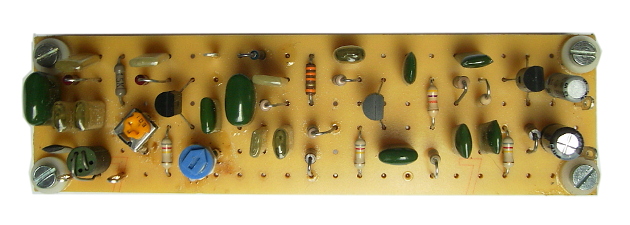Suppression of subaudio signals with the CTCSS blocker
In analog voice communication radio, the transmission of squelch sub-tones according to the CTCSS method (Continuous Tone Coded Subaudio Squelch) is widespread. Here, the modulation signal below the audio transmission range, in for communication radio usually about 300 ... 3000 Hz, a sinusoidal sound signal is added below this range. While for the squelch otherwise either the signal strength or the noise signal is evaluated and the audio signal below or above the threshold for empfangdürdige signals is turned off, this is done in the CTCSS method when the received sub-tone can not be evaluated. Here, the audio signal is switched off when no or not the right sound is present or this arrives with too small a signal-to-noise ratio. If this sub-tone were not sinusoidal, the harmonics would fall into the transmission band and interfere with the reception.
In this method, not only the noise is suppressed, but also other interference signals, which are suitable to open the squelch. In contrast to the conventional squelch, it is thus also possible to suppress transmissions from other stations which either emit a different or no sub-tone. Usual to the CTCSS method are the sub-tones listed below:
|
|
|
|
|
However, if the receiver is operated with an external speaker with a larger frequency range, these tones can be annoying. It becomes even more difficult if the signal for further processing is picked up directly at the demodulator, since the emitted CTCSS tone here practically unattenuated occurs. Particularly large problems can cause this at repeater stations, because the modulation limiter of the transmitter or even there about existing AGC or compressor units reduces the dynamic range. Even if the modulation amplifier penalizes the lower tones, such sub-tones may now appear at almost the same level as the speech signal to be transmitted. Usually after the modulation-limiting circuit only follows a low-pass, while the rejection of very lower frequency components is already performed before the limiter circuit.
To suppress a CTCSS sub-tone with a known frequency, a fixed notch filter is suitable. Usable here is, for example, a circuit with a double-T RC element. The quality can be increased by a regeneration branch.
It is more difficult, however, if the CTCSS tones should be generally suppressed. One will first assume that a high pass is then the suitable variant. With a high pass that is built around an amlifier stage, f.e. using a transistor or an operational amplifier, one achieves a slope of about 12dB/octave or 40dB/decade in general. This is by no means sufficient: a suppression of the sub-tone of 250.3 Hz with approx. 12 dB would thus weaken the speech signals to be transmitted up to more than 500 Hz and would thus significantly worsen the sound. Especially for the latter case of processing for repeater transmission but a suppression of 12 dB is still far too little. From a mathematical point of view, this initially shows that a filter group with four stages (48 dB/octave) might just be sufficient to barely alterate the speech signal with sufficient suppression of the sub-tones. But since the suppression of this group does not begin at once at 300 Hz with the refered slope, this is also not the case. As confirmed by practical experiments, it is difficult to find a sizing that offers a good compromise between good suppression of the CTCSS tone and minimal frequency response alteration of the speech signal. The distance from 250 Hz to 300 Hz is simply too low! Based on these fundamental considerations and corresponding experiments, the circuit shown below emerged.

Here three Notchfilter with different Q factor and mid frequency are used. The first filter is tuned to about 220 Hz and a suitable Q so that the speech signal is minimally affected and the CTCSS tone of 250.3 Hz is sufficiently suppressed. I first tested this arrangement in combination with a multi-stage high-pass filter in order to achieve sufficient edge steepness in the transition region. It turned out, however, that with less effort overall, the better effect can be achieved with two further notch filters (155 Hz and 70 Hz) with a staggered lower Q factor. The Q factor is the reciprocal of the relative bandwidth, so that these filters from stage to lower in each case a wider range. The smaller supression due to the lower quality is compensated by the dimensioning of the coupling capacitors. They therefore act in conjunction with the input impedances of the filter stages as additional high passes. It can be so over the entire range of CTCSS tones sufficient suppression in a steep onset below 300 Hz and so minimal impact on the voice signal achieve.

I have assembled the circuit in the construction technique popular with me for transistor circuits on a 5.08 mm solder dot grid board. This construction can be seen in the photos above and below. The assembly is successfully in operation at the amateur radio repeater DB0XH in the west of Hamburg.
